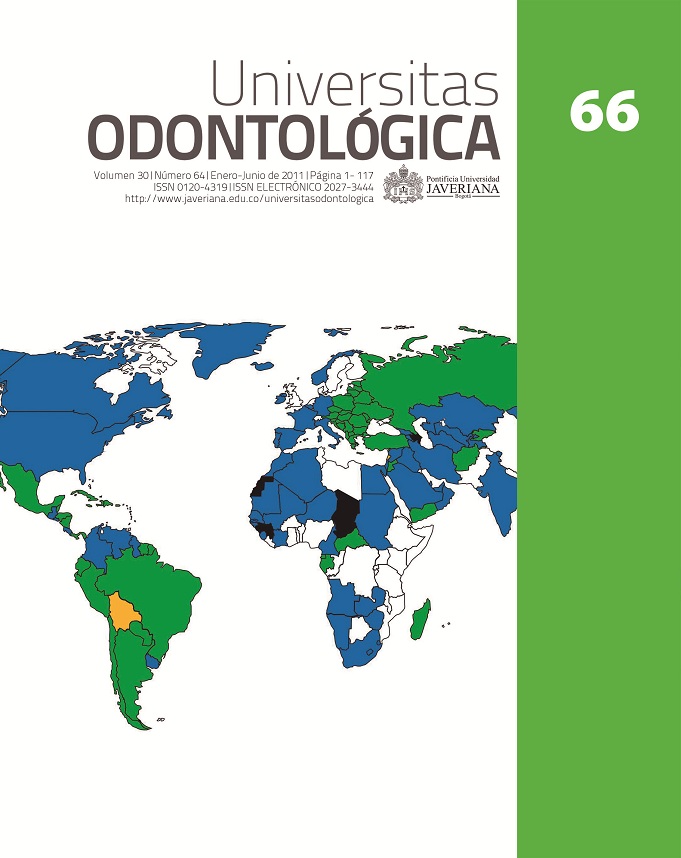Abstract
Antecedentes: es importante evaluar el primer molar permanente, ya que en edad escolar es el diente permanente más afectado por caries. La prevalencia de caries en estos dientes se ha asociado con la actividad futura de caries. Objetivo: determinar la prevalencia de caries y las necesidades de tratamiento de los primeros molares permanentes en la población escolar de 12 años de las escuelas oficiales del municipio de Rionegro (Antioquia). Métodos: se realizó un estudio descriptivo transversal en 808 escolares de 12 años de escuelas públicas del municipio. Se analizó la prevalencia de caries dental en el primer molar permanente por número y tipo de dientes afectados y de acuerdo con sexo, escolaridad, zona de residencia y afiliación al Sistema General de Seguridad Social en Salud (SGSSS). También se describieron las necesidades de tratamiento para cada primer molar permanente. Resultados: los molares inferiores presentaron la mayor prevalencia de caries dental en relación con las variables de afiliación al SGSSS, sexo y zona de residencia; en estas dos últimas variables se evidenció más afectación en el primer molar inferior derecho y concentración en este molar de las necesidades de tratamiento restaurativo. Conclusiones: aunque se cuenta con estudios previos sobre prevalencia de caries dental en el municipio que muestran cumplimiento de metas de la Organización Mundial de la Salud, son más escasos los estudios que evalúen de manera individual los primeros molares permanentes para orientar políticas de salud pública dirigidos a la preservación de estas importantes estructuras dentales.
Background: Evaluation of the first permanent molar is important since it is the tooth that is most affected from dental cavities in schoolers. Caries prevalence of this molar has been associated with future caries activity. Objective: Determine caries prevalence and treatment needs in the first permanent molar of a 12-year-old population from public schools in the municipality of Rionegro (Antioquia). Methods: A descriptive study in 808 12-year-old school children from public schools in Rionegro was conducted. Caries prevalence in the first permanent molar was analyzed regarding number and type of teeth affected and association with sex, grade, zone of residence, and type of affiliation to the social security system (SSS). Needs for dental treatment in this molar were also described. Results: Lower molars were the most affected by dental caries in relationship with sex, SSS, and zone of residence; in the latter two dental cavities were more prevalent in the right lower first molar, tooth in which the need for restorative treatment is higher than the other first molars. Conclusions: Although there are previous studies on the dental health status in Rionegro and indicators show that the goals of the World Health Organization are being met, evaluative research focused on the first permanent molar is scarce and necessary given its importance for health public policymaking intended to preserve this teeth.
This journal is registered under a Creative Commons Attribution 4.0 International Public License. Thus, this work may be reproduced, distributed, and publicly shared in digital format, as long as the names of the authors and Pontificia Universidad Javeriana are acknowledged. Others are allowed to quote, adapt, transform, auto-archive, republish, and create based on this material, for any purpose (even commercial ones), provided the authorship is duly acknowledged, a link to the original work is provided, and it is specified if changes have been made. Pontificia Universidad Javeriana does not hold the rights of published works and the authors are solely responsible for the contents of their works; they keep the moral, intellectual, privacy, and publicity rights.
Approving the intervention of the work (review, copy-editing, translation, layout) and the following outreach, are granted through an use license and not through an assignment of rights. This means the journal and Pontificia Universidad Javeriana cannot be held responsible for any ethical malpractice by the authors. As a consequence of the protection granted by the use license, the journal is not required to publish recantations or modify information already published, unless the errata stems from the editorial management process. Publishing contents in this journal does not generate royalties for contributors.


